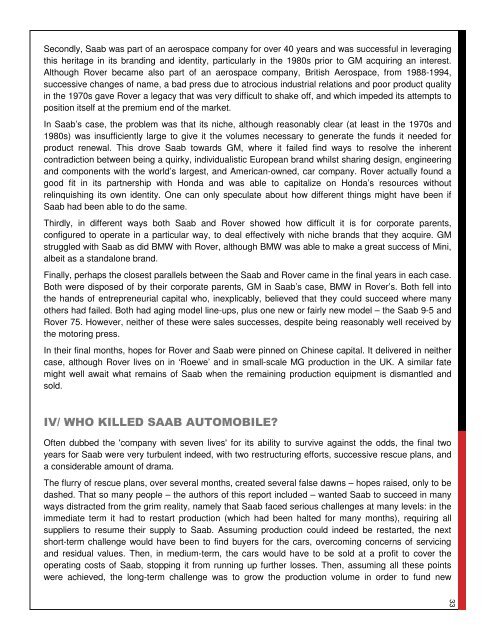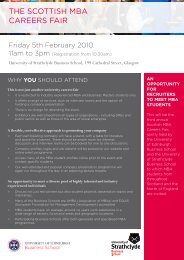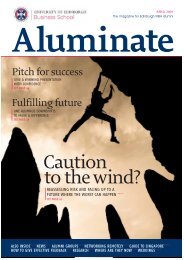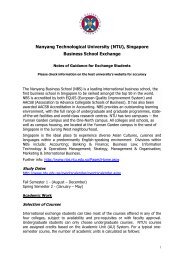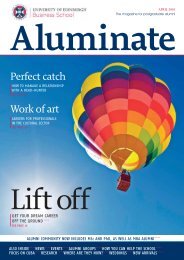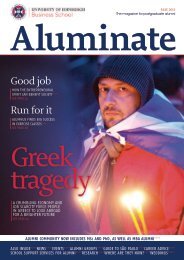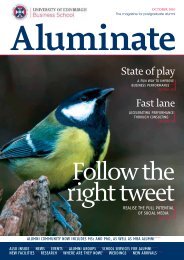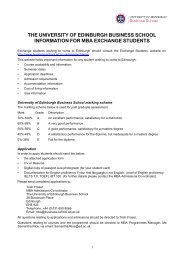killed Saab Automobile? - Business School - University of Edinburgh
killed Saab Automobile? - Business School - University of Edinburgh
killed Saab Automobile? - Business School - University of Edinburgh
You also want an ePaper? Increase the reach of your titles
YUMPU automatically turns print PDFs into web optimized ePapers that Google loves.
Secondly, <strong>Saab</strong> was part <strong>of</strong> an aerospace company for over 40 years and was successful in leveraging<br />
this heritage in its branding and identity, particularly in the 1980s prior to GM acquiring an interest.<br />
Although Rover became also part <strong>of</strong> an aerospace company, British Aerospace, from 1988-1994,<br />
successive changes <strong>of</strong> name, a bad press due to atrocious industrial relations and poor product quality<br />
in the 1970s gave Rover a legacy that was very difficult to shake <strong>of</strong>f, and which impeded its attempts to<br />
position itself at the premium end <strong>of</strong> the market.<br />
In <strong>Saab</strong>’s case, the problem was that its niche, although reasonably clear (at least in the 1970s and<br />
1980s) was insufficiently large to give it the volumes necessary to generate the funds it needed for<br />
product renewal. This drove <strong>Saab</strong> towards GM, where it failed find ways to resolve the inherent<br />
contradiction between being a quirky, individualistic European brand whilst sharing design, engineering<br />
and components with the world’s largest, and American-owned, car company. Rover actually found a<br />
good fit in its partnership with Honda and was able to capitalize on Honda’s resources without<br />
relinquishing its own identity. One can only speculate about how different things might have been if<br />
<strong>Saab</strong> had been able to do the same.<br />
Thirdly, in different ways both <strong>Saab</strong> and Rover showed how difficult it is for corporate parents,<br />
configured to operate in a particular way, to deal effectively with niche brands that they acquire. GM<br />
struggled with <strong>Saab</strong> as did BMW with Rover, although BMW was able to make a great success <strong>of</strong> Mini,<br />
albeit as a standalone brand.<br />
Finally, perhaps the closest parallels between the <strong>Saab</strong> and Rover came in the final years in each case.<br />
Both were disposed <strong>of</strong> by their corporate parents, GM in <strong>Saab</strong>’s case, BMW in Rover’s. Both fell into<br />
the hands <strong>of</strong> entrepreneurial capital who, inexplicably, believed that they could succeed where many<br />
others had failed. Both had aging model line-ups, plus one new or fairly new model – the <strong>Saab</strong> 9-5 and<br />
Rover 75. However, neither <strong>of</strong> these were sales successes, despite being reasonably well received by<br />
the motoring press.<br />
In their final months, hopes for Rover and <strong>Saab</strong> were pinned on Chinese capital. It delivered in neither<br />
case, although Rover lives on in ‘Roewe’ and in small-scale MG production in the UK. A similar fate<br />
might well await what remains <strong>of</strong> <strong>Saab</strong> when the remaining production equipment is dismantled and<br />
sold.<br />
IV/ WHO KILLED SAAB AUTOMOBILE?<br />
Often dubbed the 'company with seven lives' for its ability to survive against the odds, the final two<br />
years for <strong>Saab</strong> were very turbulent indeed, with two restructuring efforts, successive rescue plans, and<br />
a considerable amount <strong>of</strong> drama.<br />
The flurry <strong>of</strong> rescue plans, over several months, created several false dawns – hopes raised, only to be<br />
dashed. That so many people – the authors <strong>of</strong> this report included – wanted <strong>Saab</strong> to succeed in many<br />
ways distracted from the grim reality, namely that <strong>Saab</strong> faced serious challenges at many levels: in the<br />
immediate term it had to restart production (which had been halted for many months), requiring all<br />
suppliers to resume their supply to <strong>Saab</strong>. Assuming production could indeed be restarted, the next<br />
short-term challenge would have been to find buyers for the cars, overcoming concerns <strong>of</strong> servicing<br />
and residual values. Then, in medium-term, the cars would have to be sold at a pr<strong>of</strong>it to cover the<br />
operating costs <strong>of</strong> <strong>Saab</strong>, stopping it from running up further losses. Then, assuming all these points<br />
were achieved, the long-term challenge was to grow the production volume in order to fund new<br />
33


